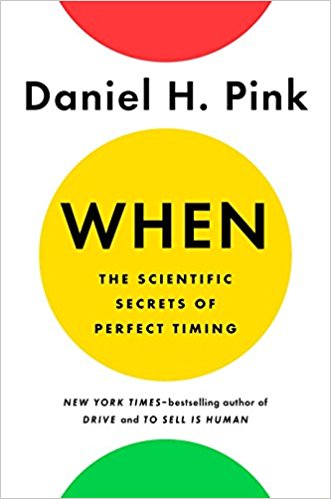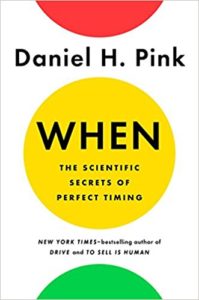A few years back, consultants with ghSMART told us the biggest question we face is “who”: Picking staff is our most important decision, even more critical than “what” – the strategy we will employ. These days, in an era in which purpose is prized, “why” can often be the biggest question.
But recently, best-selling author Daniel Pink turned our attention to “when” – the scientific secrets of timing. “We all know that timing is everything. Trouble is, we don’t know much about timing itself,” he writes in When, which he calls a “when-to” rather than “how-to” book.
When
By Daniel Pink
Riverhead Books, 258 pages
He starts with moods. Positive mood rises in the morning, dips in the afternoon, and rises again in the evening. Breaking that down, research has shown:
- People feel increasingly happy throughout the morning, less happy in the afternoon, and happier again in the evening.
- People feel increasingly warm towards others throughout the morning, less warm in the afternoon, and warmer again in the evening.
- People enjoy themselves more as the morning unfolds, enjoy themselves less in the afternoon, and begin enjoying themselves again in the evening.
- Emotional balance rises in the morning, dips in the afternoon, and rises again in the evening.
“Moods are an internal state, but they have an external impact. Try as we might to conceal our emotions, they invariably leak – and that shapes how others respond to our words and actions,” he notes.
So be careful in the afternoons. A study of CEOs holding communication calls with investors found they should be conducted earlier in the day because as the day progresses, the tone grew more negative and less resolute. That probably applies to your own communications as well, in some way.
Except it’s not quite that simple. Science never is, nor are human beings. Add to the mix the question of chronotype – whether you are a lark, owl or third bird. You probably have considered at some point whether you are a lark or owl – common terminology that most of us encounter in our teens – as we learn whether we prefer to go late into the night or start early in the morning with work or play. In fact, most of us actually are what he calls third birds: somewhat in the middle. Twenty-one per cent of the population are night owls, 14 per cent larks, and 65 per cent third birds.
We can’t do much about chronotype. Genetics explains at least half the variability in chronotype, suggesting that larks and owls are born not made. Interestingly, people born in fall and winter are more likely to be larks and those in spring and summer, owls.
A key issue is that all of us experience the day in three stages – a peak, a trough, and recovery. About three quarters of us – larks and third birds – experience it in that order. That is reflecting in the description of moods already described. “But about one in four people, those whose genes or age make them night owls, experience the day in something closer to the reverse order, recovery, trough, and peak,” Pink says. And whatever is your pattern, he warns to be mindful of your troughs. They can be more dangerous than you realize.
Hospitals are encouraging health workers to sanitize their hands. But one study found that they are less likely to do it in the afternoon – for many their trough. Students fair worse in tests taken in the afternoon without a good mid-day break. Judges are more lenient in the morning and then by late morning that fades, with nearly no favourable rulings. After lunch break, they are more forgiving, but then in a few hours become hardline again.
The research suggests we need a modern siesta. Since it’s unlikely the government will grant you and your colleagues one, you need to work out how to sneak one in so that the government, despite its lack of generosity, gets more productivity from you. He offers five guiding principles: Trying something beats not doing anything; moving beats being stationary; social, being with others, beats solo, except perhaps for introverts who like to replenish alone; outside beats being inside; and being psychologically and fully detached from work for a period beats being semi-detached.
Naps can be ideal. Pink used to hate them – considering them pathetic for grown-ups – but has changed his mind and ways, working them into his day. Naps improve cognitive performance and mental and physical health. “In many ways, naps are Zambonis for our brains. They smooth out the nicks, scuffs and scratches a typical day has left on our mental ice,” he writes.
But naps aren’t available to most of us most days. So he provides a menu of five kinds of restorative breaks:
- Micro-breaks: A replenishing break need not be lengthy. It can even be a minute of less. He shares the 20-20-20 rule: every 20 minutes look at something 20 feet away for 20 seconds. Also, get a smaller water bottle so you have to go to the water fountain more frequently to refill it. And try getting up occasionally for 60 seconds, shaking your arms and legs, flexing your muscles, and rotating your core.
- Moving breaks: You probably sit too much and move too little during the day, so build more movement into your breaks. He suggests a powerful act can be to take a five-minute walk every hour – they are particularly useful in the trough. Try some yoga poses like chair rolls, wrist releases and forward folds. Or build your push-up ability, starting with two a day, and each week adding two more. “You’ll boost your heart rate, shake off cognitive cobwebs, and maybe get a little stronger,” he says.
- Nature break: Go outside and find a place to sit and think. Or if there’s a nearby park, take a walk. “This might sound ‘tree-huggery,’ but study after study has shown the replenishing effects of nature. What’s more, people consistently underestimate how much better nature makes them feel,” he says. Indeed, even looking at some indoor plants or out the window has been shown to have a positive effect.
- Social break: Reach out and call somebody you haven’t talked to awhile, catching up for five or 10 minutes. Or send a thank you by email to somebody. If you can, plan a regular walk or visit to a coffee shop with someone, regularly or occasionally.
- Mental gear-shifting break: Give your brain a break by meditation, or listen to a comedy podcast, or put on your headphones and jam along with a favourite song. Try controlled breathing: Take a deep breath, expanding your belly. Pause. Exhale slowly to the count of five, then repeat the process four times. It will take about 40 seconds, sharpening your thinking and maybe even strengthening your immune system.
Anders Ericsson’s study of violinists led to the prescription by author Malcolm Gladwell that to be successful we need to put in 10,000 hours on a chosen field. But less noticed were Ericsson’s findings about rest: “One factor that distinguished the best from the rest is that they took complete breaks during the afternoon…whereas nonexperts were less rigorous about pauses. We might think the superstars power through the day for hours on end. In fact, they practise with intense focus for 45- to 90-minute bursts, then take meaningful restorative breaks.”
So think “when.” Consider your own patterns over the day, how your moods and productivity fluctuate, paying particular attention to troughs. And then tweak your schedule, to the extent you can. High on your lists might be a modern siesta.


